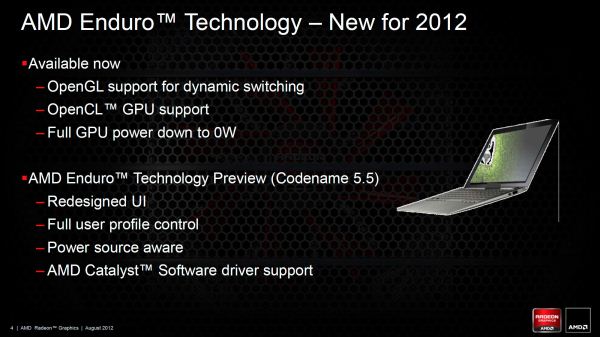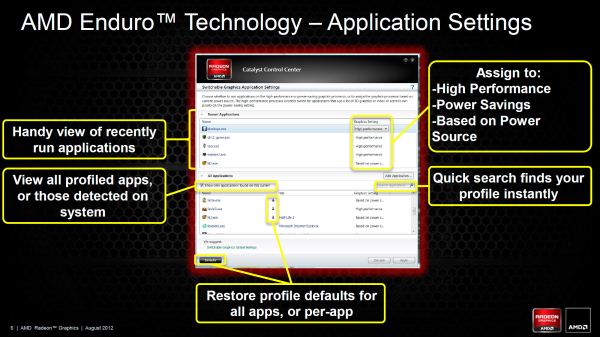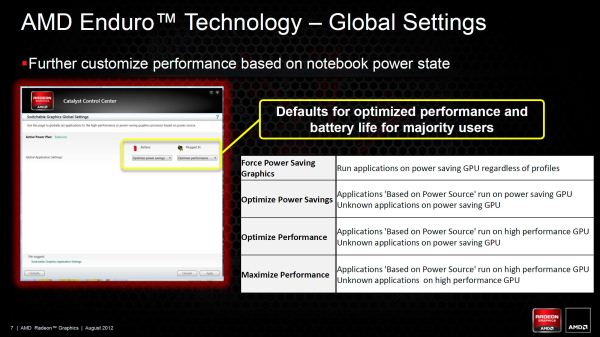AMD’s Enduro Switchable Graphics Levels Up
by Jarred Walton on September 6, 2012 3:00 AM ESTNew for Mid-2012: “Enduro 5.5” Enhancements
When AMD created the Enduro brand, they were really almost where we wanted them. They had dynamic switching with support for most of the latest games and applications, and when it worked properly it would be difficult to tell if you were using an NVIDIA or an AMD dGPU. The problem was when things didn’t work and you had to go into the drivers, and there were several problems. OpenGL support was totally out, many of the latest games were also missing default profiles (and sometimes wouldn’t let you properly specify the correct GPU), the UI was obtrusive and sometimes hard to use (particularly for power users), and the drivers were dictated by the laptop manufacturers and were usually months old at launch and never updated.
While the UI seems like a minor thing to fix—I would have thought one or two months to improve the UI would have been sufficient—at least prior to the forthcoming update it remained largely unchanged. The lack of AMD-provided driver updates was really the major issue, because everything else could potentially be fixed with new drivers and you would never know. The other areas like OpenGL/OpenCL and support for various games/applications should improve over time as well, provided you can get drivers. That brings us to the upcoming Enduro release, scheduled to come out sometime this month or next. Officially it’s still just Enduro, but to help differentiate between the previous Enduro release and the upcoming release we’ll sometimes refer to the new version as “Enduro 5.5”.
The biggest news with the latest iteration of Enduro is that AMD is planning to make universal reference drivers available for all the Enduro laptops. It’s not clear precisely what that means, but potentially any laptop with Dynamic Switchable Graphics or later (e.g. PX4.0 and later) would be supported by AMD’s “reference” drivers. That’s huge, and if AMD can deliver it will assuage most of our concerns with their hardware/software. Hopefully none of the OEMs get bent out of shape or refuse to allow support, which is a problem we've seen in the past. We should see the first public release in the next month or two, and then another release somewhere in the November/December timeframe.
Besides the availability of driver updates, the UI also receives a much needed overhaul, providing both regular and power users all the options they’re likely to need as far as control of graphics switching is concerned. Open up the switchable graphics options and the top section remains largely the same, but the bottom now allows you to see all application profiles (or just the profiles for detected applications). There’s also a quick search option that works both on executable name and application/game name (e.g. HL2.exe or Half-Life 2 will both find the profile for Half-Life 2). From either list (recently used apps up top, or all apps at the bottom), you can set the GPU profile.
Where previously there were two settings (three if you count “Not Assigned”), there are now three options. As before, “Power saving” sets an application to run on the integrated graphics while “High performance” sets an application to run on the discrete GPU. The new third option is “Based on power source”, which does precisely what you’d expect: plug the laptop in and the apps with this setting will run on the discrete GPU; switch to battery power and they’ll run on the integrated graphics. For many users, everything could default to “Based on power source” and they would be happy, but certainly there will be times where you’re running on battery power but still want to use the dGPU and the drivers give you that option. Should things get squirrelly, you can also reset applications individually or globally to their default settings. It’s worth noting that the power state aware setting is something that NVIDIA currently does not implement, requiring manual intervention if you wish to override your normal settings—though how often people are using apps that require the dGPU while on battery power is something we could debate.
Besides the individual application profiles, AMD is also adding a new area to their drivers: Switchable Graphics Global Settings. This is something you could sort of get before with some laptops, but previously it involved changing from Dynamic Switchable Graphics to manual switching (i.e. switching based on power source) and then forcing the laptop into High Performance or Power Saving mode if you wanted to be low power while plugged in or high power while unplugged. That was clunky and at least in the case of the Sony VAIO C we tested it caused flickering similar to the old switchable graphics, with the dGPU drivers getting unloaded and iGPU drivers getting loaded (or vice versa), with some work behind the scenes copying context from one GPU to the other. It worked but it wasn’t elegant; perhaps more importantly, Microsoft doesn’t want anyone doing this with Windows 8 and thus new laptops won’t be able to get a Windows 8 sticker if they use this method of switching (which basically means no new laptops will do this). To make up for the loss of this functionality (which some people still prefer), AMD has added a new global settings section.
Unlike the individual application profiles, the global settings gives you four options each for Battery and Plugged In. The top two options are similar in most cases and will generally run most applications on the iGPU, and the same goes for the bottom two modes where you’ll run most apps on the dGPU. The difference is that “Force Power Saving GPU” will run all applications (regardless of what the custom profile says) on the iGPU, essentially disabling the dGPU completely. “Optimize Power Savings” in contrast will run all unknown or “Based on power source” applications on the iGPU while respecting the application profiles where they exist. “Optimize Performance” is sort of the reverse of that, running all “Based on power source” applications on the dGPU while leaving unknown applications on the iGPU. Finally, the “Maximize Performance” option runs all unknown and “Based on power source” applications on the dGPU—but applications specifically set to use the iGPU will continue to do so.
The reason for that last discrepancy (e.g. why you can’t simply run everything on the dGPU and forget about the iGPU) is that certain tools have to run on the iGPU. Intel’s drivers are one example—loading those up on the dGPU would cause problems. Intel’s WiDi is the only other I could find on my particular Clevo notebook. We were told that some of the laptop utilities like an overlay showing percentage of brightness, volume, etc. may also need to run on the iGPU. Besides the few applications that have to run on the iGPU, any applications that are set to Power Saving will continue to use the iGPU—and this makes sense as there are a lot of applications that can be set to run on iGPU/dGPU that have no need of higher performance GPU options (several anti-virus utilities come to mind, where they're starting to create a 3D context for their UI). The net result is that other than a few specific applications where the profile will exist and be locked to the iGPU, with no option to change to dGPU, everything else that uses higher function graphics can be customized to run on a specific GPU, but if you set something to iGPU presumably you want it to always run there—otherwise you would use the “Based on power source” setting.
A full set of screenshots from all the driver screens is available in the gallery below if you’re interested.
One final topic worth discussing is Windows 8. Certainly there are owners of existing laptops with switchable graphics that are wondering if they can upgrade to Windows 8 and what will happen. We’ll have to see how this actually plays out, but it sounds like the earlier versions of PowerXpress (3.0 and earlier) will probably get support with one driver bundled with Windows 8, and that may be it—but there’s always the possibility for the laptop OEMs to release their own updates, or for AMD to roll out additional drivers for older laptops. The potential for PowerXpress 4.0 and later laptops to get regular driver updates (for Windows Vista/7/8) is there, but until we actually start seeing public driver releases AMD hasn’t fully committed to supporting all of those laptops.



















200 Comments
View All Comments
TokamakH3 - Friday, September 7, 2012 - link
Reading the article, one would never know the P170EM he has is much less powerful than an exactly spec'd MSI or Alienware system, all because of Enduro.sirizak - Thursday, September 6, 2012 - link
Can we get a comment from Anand in here that he is taking this issue up with AMD? He may just have enough reputation to wake them from their slumber on this ongoing and damaging issue.Please Anand, help us fight the good fight!!
silverblue - Thursday, September 6, 2012 - link
I think the fact that Jarred works at AT should be more than enough. :)If AMD are having developmental issues, it'd be nice if they could open up their development more, get more external help. Not every gamer shies away from diagnosing a good problem, and there's a lot of clever people out there who can at least pinpoint issues with certain hardware configurations. All too often, complaints drown everything else out.
hulawafu77 - Thursday, September 6, 2012 - link
Unfortunately AMD is giving the cold shoulder to everyone on this issue. Caveman on Rage3D has confronted a stone wall when inquiring about progress on Enduro. AnandTech did reach out to AMD and all they got was a rumored fix with two drivers for a 12 month period with proper GCN support. That's incredible...We have one tweet for the customers, that's it. Nothing more. If it wasn't for Anandtech here, we wouldn't eve know there is a suppose Enduro 5.5 in the works, if that is actually being worked on. Andandtech was not given a test build on the driver to see if it actually works.
JarredWalton - Thursday, September 6, 2012 - link
This whole article is a result of us "taking it up with AMD". I know people who already bought the product want it fixed yesterday, but that's just not the way things work, especially with driver development. Mess up the drivers in some small way and everyone gets BSODs. Heck, they could have everything ready for the drivers to release and just need to do a solid two months of QA before sending it out to the public. I won't share the specifics, but let me just say that if AMD had given me the beta driver and I had tried to do the install on my own, I'm pretty sure that I would have ended up doing a full reinstall of my OS and apps. That's not because the driver is broken, but the install routine wasn't fully optimized at the time (two weeks ago). That's part of what they're still working on, along with other performance optimizations.Seanzky - Thursday, September 6, 2012 - link
Quick question, Jarred. I'm not trying to put you on the spotlight here, but maybe you know. Obviously, we've already tried reaching out to resellers and even Clevo. Do you think their silence to our inquires means they ignored us or do you think they actually relayed our concerns to AMD? Because if it were the latter, I would think AMD gave them the same assurance AMD gave you which the resellers would do well to relay to us. Your article, I call it the "great hope for Enduro", is the first I've ever heard of AMD working on anything remotely related to the issues we're experiencing. Honestly.What are your thoughts on those because I feel like resellers are somewhat avoiding us based on some of the feedback I've seen. I just want to know this isn't my imagination or paranoia.
JarredWalton - Thursday, September 6, 2012 - link
I think the resellers were trying to avoid telling people that there are no immediate fixes available. I'm sure they brought it up with AMD, and AMD's response was likely, "We're working on it but don't have a definite time for when our fix will be available." When that happens, the best thing from the reseller's standpoint is usually to say nothing. I'm not saying it's best for the consumers, mind you, but it's better to keep your mouth shut than to admit to problems, and if anyone is really vocal you just let them return the product.As for AMD, I commented above just a second ago that I'm betting the driver team eventually had to come back and tell marketing and management that they needed a solid six months of time to fix and test the new drivers before they could address the problems with Enduro. Management was likely pissed, but what can you do when your drivers aren't working the way you want? It's not like you can just hire new people or do a quick hack that makes everything better, so you have to wait, and again silence is often better than promising something you can't deliver (yet).
The fact that AMD gave me a firm deadline of October 31 for the public release of the drivers I'm using is really good news. Last year when I ripped on DSG (pre-Enduro but essentially the same), AMD told me they were working on getting regular driver updates "soon" and independent AMD and Intel driver installs "after that". I asked for some time frame and got hemming and hawing. This time, we have a date, we have beta (or maybe pre-beta) drivers in hand, and I really do expect AMD to at least get the 9.0 series Enduro Catalyst drivers out by the end of October, and hopefully sooner. I think those drivers will still have issues, but provided all of the framework is in place for future updates, things can only go up from there.
Seanzky - Friday, September 7, 2012 - link
I hope your optimism ends up right over my lost of faith in AMD. It would really suck, to say the least, if this was AMD taking us for another spin.andrewaggb - Thursday, September 6, 2012 - link
I've always stuck with non-switchable graphics despite the worse battery life because I wanted a guarantee of driver updates.This sounds terrible though. And deleting threads and not responding sounds a lot like people trying to cover up a problem. That makes me not very optimistic that a new magic driver will fix the problem.
Best of luck. I've had excellent driver feedback/response from AMD in the past, so it's sad to hear things have gone way down hill.
hulawafu77 - Thursday, September 6, 2012 - link
So do we all with high performance. But AMD is now implementing switchable graphics muxless design to even their high end products.Let's just hope AnandTech's inquiry into switchable graphics support is correct and AMD is taking this seriously.